The Lot Valley, the kingdom of black wine.
I wanted to share something different you may not find elsewhere: a journey on the Lot Valley in France and its wine. Most of the time, books will teach you about the South West region as if it were a single terroir. This is not the case. South West is a mosaic of terroirs, but some of them share something special.
This is the case for the Lot Valley. The Lot River run from the Massif Central in the East to the Garonne River in the West. It has carved out the landscape of these regions and has been an important communication and trade route. With time vineyards in the valley gain their identity but they are still sharing something in common.
This page is a journey, a journey in the valley from west to east to discover these ancestral and history-rich wine regions.
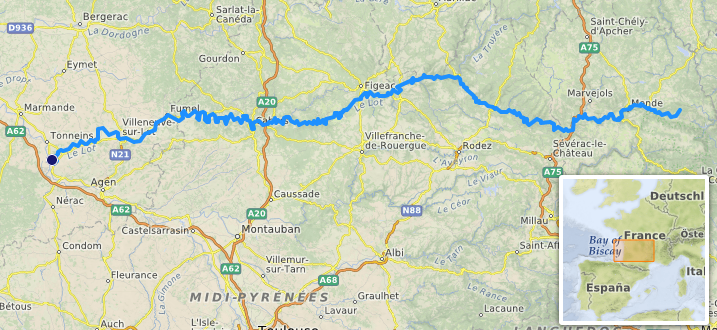
The Lot River region has been inhabited since prehistoric times. Winemaking was first documented during the Roman occupation. The river was at the confluence of the pilgrimage routes of Santiago de Compostela in the Middle Ages.
The wine from the valley became famous during the Middle Ages. It was called black wine. The term was introduced to qualify a very dark wine that started to be produced in the region. The opposite of the wine produced elsewhere, which was clear and made with a short maceration.
This black wine was mainly produced around the Lot Valley, in the former province of Quercy (today the Lot department, part of Aveyron, and the northern part of the Lot et Garonne) on the West Side and the province of Rouergue on the East Side.
The notoriety of the black wine didn’t stop at the limit of the province, it was exported to Bordeaux and from there the English Kingdom. It could be found at the table of English kings or Russian nobles. Geography played a role in the wine’s notoriety. The Lot River flows into the Garonne River which joins de city of Bordeaux. At the time when River navigation was the only efficient means of transport, it was a huge advantage.
At the end of the Middle Ages, the wine from the region was considered superior to Bordeaux wines. At this time the city of Bordeaux was the main trade port for wine, and it was the only way to export in England and elsewhere. Bordeaux used the situation to give priority to their wine. They, even, mixed the wine from the lot valley with their clear wine, to raise the quality.
The eastern part of the valley was less lucky, the wine produced in what is now the Aveyron department has a local notoriety but was not exported outside the old provinces and gained less popularity.
They were two secrets behind the success of the Black Wine from the Lot Valley. The process to produce the black wine is the first one. Many sources indicate that from the Middle Ages until the 19th century, a small part of the harvest was roasted in the oven before the vinification.
The other secret is the grape varieties used in the region. According to sources, the main variety in Cahors was named Côt or Auxerois, a dark-skinned variety.
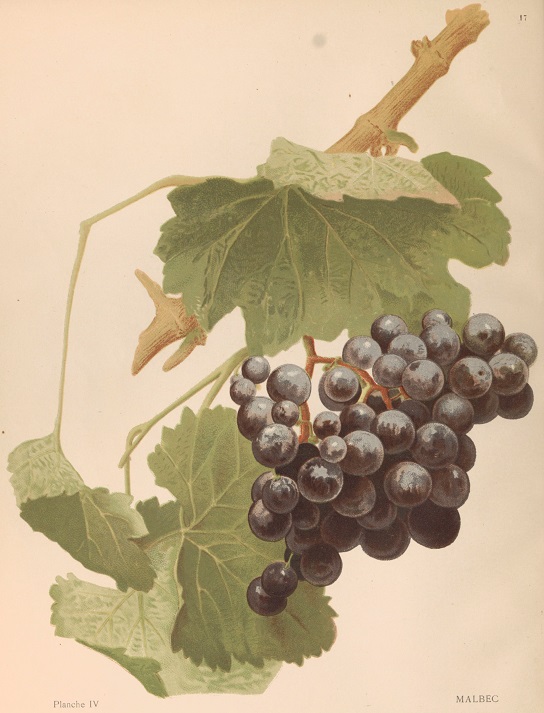
The Lot Valley is on the path to Santiago de Compostela. Pilgrims often travel with their wines and some cultivars from other regions. This is why you could find Chenin Blanc from the Loire Valley or Cabernet Franc from Spain.
The wine from the Cahors was so popular, that the François 1er, King of France in 1515, planted the main variety from the Lot in the Loire Valley with the name Auxerois. Auxerois became so popular, that people started to plant it everywhere. Some merchants imported the vines from the Quercy to be used in vineyards. One of them, in the Medoc area in Bordeaux, was called Malbeck, this is how Auxerois started to be called Malbec in Bordeaux. Bordeaux has one of the biggest notoriety in the world, the rest of the world started to call Auxerois, Malbec.
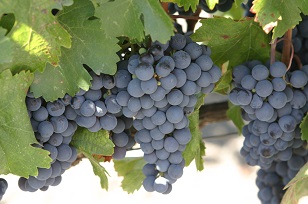
But the region didn’t produce only red wine. Every area of the valley produced Red, rosé, and white wine, but mainly for local consumption. We do not have much information about varieties used to produce white wine in old age. We are only aware of Chenin Blanc and Mauzac. We also know that the Chenin Blanc variety is different than the Chenin Blanc from the Anjou region with a slight difference in the taste.
As you see, wine was produced in all parts of the valley, from the actual Lot department to the northern part of the Aveyron and the western part of Cantal departments. Most of the production was sold on local markets and only Cahors wine was intended for export.
However, an event tragically changed the wine geography, the Phylloxera crisis. At the end of the 19th century, a small aphid from the USA landed in the south of France and devastated almost all the European vineyards in a few years, only a few places were spared.
The vineyards of the Lot Valley were decimated, but the worst was that the only solution against the bug could not work here. Elsewhere, winegrowers could craft vines with American roots resisting the plague. But in the Lot Valley, it wasn’t possible, the American roots could not support the limestone soil, and when the soil could sustain American roots, like in the east part of the valley, it wasn’t economically suitable.
Many solutions were tested, but finally, winegrowers started using hybrid varieties to maintain the vineyard; The wine from these grapes didn’t have the same taste and quality as the main varieties used before.
Fortunately, Malbec was only reintroduced in Cahors in 1947 with new varieties, Merlot and Tannat, and in 1971, the vineyard got its appellation Cahors AOC.
Elsewhere, the situation is not the same, the vineyard was never really restarted. There are a few exceptions. In the East, in Aveyron and Cantal the Estaing and Entrayques vineyards remained. In the Northeast, the Glanes vineyard continued to exist.
Today these vineyards are represented by 9 appellations (AOP/AOC or IGP) in the Lot Valley from The Garonne River to Aveyron.
At the place where the Lot flows into the Garonne in the West, in the actual Lot et Garonne, is the appellation Agenais. The vineyard is 84 hectares large and produces red wine using Abouriou, Merlot, Alicante Henri Bouschet, or Bouchalès and white wine with Arriloba, Baroque, Chardonnay, or Chasan.
Between the city of Agen and the Cahors, on a limestone plateau, stands the appellation Thézac-Perricard. With a 63-hectare vineyard, the appellation produces mainly red wine using Cabernet Franc, Merlot, Malbec, Cabernet Sauvignon, and Gamay.
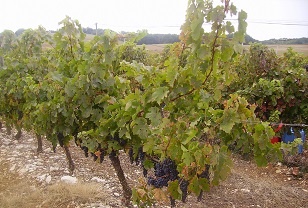
Between the departments of Lot et Garonne and Lot, lies the appellation Coteaux du Quercy. Between Gaillac and Cahors, soils are clayey-calcareous, they only produce red and rosé wines. Unlike in Cahors, the main variety is Cabernet Franc (at least 40%) with Malbec, Merlot and Tannat. The wines are fruity and spicy.
The next region is the most important one, the Cahors region. It is the most famous and the biggest of the valley. The appellation only produces red wine on 3325 hectares. Cahors has two zones, the banks of the Lot River and the high plains, 300 meters high, called Causses. The Soil is mainly made of limestone from the Jurassic and Cretacean eras. The Climate is oceanic with the influence of both the Atlantic and the Mediterranean seas. The Massif Central mountains and the Lot River play also a role in the climate of this part of the Lot.
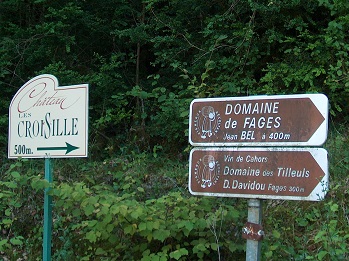
The Cahors appellation uses Malbec (70% minimum) as the principal cultivar with Tannat and Merlot. Only red wine is allowed in the Cahors appellation, but some winemakers produce white and rosé wine in the appellation area. They use the “Vin de France” appellation or the other local appellation, “Côtes du Lot”.
The “Côtes du Lot” appellation covers the department of Lot. Most of the vines grow on the limestone plateaus between the Lot and Dordogne rivers. The climate and soil are similar to the Cahors appellation—the main differences with the Cahors appellation; are Cultivars and the possibility to produce Rosé and white wine. The appellation uses Malbec, Merlot, and Tannat, but also uses Abouriou (a variety coming from the Lot et Garonne department), Cabernet Franc, Cabernet Sauvignon, Gamay, Cinsault, Jurançon Noir, Syrah, and many other for red and rosé wine.
White Wine uses Chenin Blanc (a local declination of the emblematic Anjou variety), Chardonay, Loin de l’oeil, Mauzac, Viognier and Semillon Blanc.
In the Northeast of the Lot department, there is another appellation, Coteaux de Glanes. This young appellation (IGP since 2011) produces wine using Merlot and Cabernet Franc for the red and Chardonnay, viognier, and Chenin Blanc for the white. The vines are planted at the top of well-exposed hillsides, on a well-drained clay-limestone soil. The size of the appellation is 36 hectares.
Following the Lot River to the East, outside the Lot Department, in Aveyron, there are 3 other historic wine regions.
The first one is the Entraygues-le-fel near the north of the department. It is in reality two wine regions, Entraygues sur Truyère and the Fiel. This is the last navigable part of the Lot River. The landscapes of the appellation are composed of schist soils on the Fel and granitic sands on the Entraygues. The entire vineyard is planted on hillsides with steep slopes.
Red wine is made using the Fer variety (at least 50%) with Cabernet Franc and Cabernet Sauvignon. White wines are made using the local declination of the Chenin Blanc (at least 90%) with also Mauzac and Saint Côme. The appellation covers 14 hectares and produces only about 300 hl per year, mainly by small family-owned wineries.
Located in the south of Entraygues, the Estaing appellation is one of the oldest wine regions of the easter part of the Lot Valley. Wine has been produced here since the 10th century. Soil and geography are similar to the Entraygues-le-fel region, schist, and granitic sand.
Red wine is made using Fer (30% at least) and Gamay, with less than 50% of Cabernet Franc and Cabernet Sauvignon. The wine is, generally fruitier than in Entraygues. The white wines use the same grape varieties as in Entraygues-le-Fel. There are less than 20 winemakers in the region, they produce each year around 350hl.
Finally, on the South bank of the Lot River, there is the Marcillac region. With almost 200 hectares and 8000 hectoliters of wine produced each year, it is the biggest wine region in this part of the valley. The soil is a combination of schist like in Entraygue, limestone, and red clay loaded with iron oxide.
Only red and rosé wine is produced in Marcillac. The main variety is the Fer (90% at least), other cultivars are cabernet sauvignon, Merlot, and Prunelard.
There is a lot of diversity in the Lot Valley and it will be difficult to choose a wine, natural or not. But I have a little selection.
For the IGP Angenais, The Domaine de Quissat produces red wine from Abouriou and Merlot which are an agreeable introduction to the Lot Valley.
With over 3000 hectares, the Cahors AOP provides the largest contingent of natural winegrowers in the valley. The wines range from the most traditional to the most modern. If you think Cahors is all about full-bodied and tannic wines, you are almost wrong.
Take the domain Mas Del Perrier, Fabien Jouves took over the family Domaine in 2005 and convert it to organic farming. Wines from the Fabien Jouves are eclectic. You will find the traditional Cahors, fresh and flexible like La Roque or Amphore, but also fruity and light Malbec, Haute Côte de Fruit. But Fabien Jouves don’t work only with Malbec you can find an incredible Chenin, “Les pieces longues”, orange wine, les Agudes, or a rosé “A table”.
Still in Cahors, you can find the Clos Troteligotte, Cosse Maisonneuve or Combel la Serre.
In the Coteaux du Lot, the Chateau Lagrezette offer an excellent Viognier “Le Pigeonnier White Vision” and a Syrah La Magnifique de Rocamadour (conventional wine).
If we look at the easter part of the valley there are some nice references. Installed in 2018 in the Entraygues Le Fiel appellation, Pauline Broqua, produces elegant wines like “De Toute Façon Le Vent Souffle” or “Chauffe Marcel” using Fer and other cultivars or “Les brumes” made with Chenin Blanc.
Not so far away, the “Domaine Nicolas Carmarans” produces wondrous wines. A very pur wine, “Mauvais Temps”, is made using Fer and Negret or Selves with Fer, Gamay, Pinot Noir, and Negret.
In the last region, Marcillac, you can taste the wine from Marc Fraysse, Domaine des Boissières, “La quille de rouge”, an excellent example of the Fer variety in the region.
The Lot River is a land of history and a land of wine, built on the river as a waterway and on the pilgrim’s roads. There is a vast of wine, white, red, black, and rosé with an infinity of tastes. It is worth taking the time to discover these wines in all their splendor.